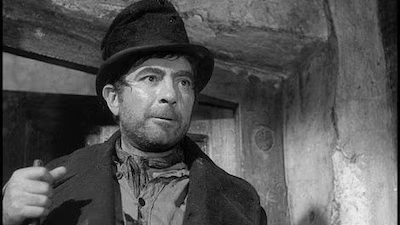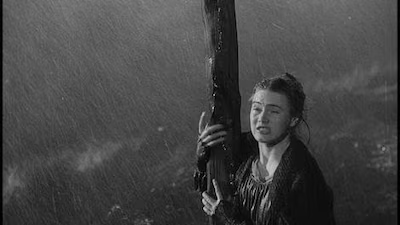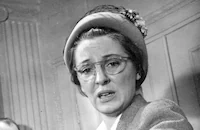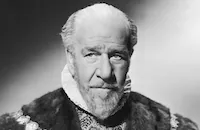Oliver Twist

Brief Synopsis
Cast & Crew
David Lean
John Howard Davies
Robert Newton
Alec Guinness
Kay Walsh
Francis L. Sullivan
Film Details
Technical Specs
Synopsis
The immortal characters of Charles Dickens' classis novel, Oliver Twist...A penniless orphan in 17th century London... Poor but honest Oliver is fleeing the cruelty of the workhouse when he's forced in a band of young thieves headed by the notorious Fagin and the evil Bill Sikes. But when the greedy cutthroats threaten Oliver's only chance for happiness, the gentle-hearted boy must summon the courage to fight for his freedom and future.
Director

David Lean
Videos
Movie Clip





Trailer
Hosted Intro
Film Details
Technical Specs
Articles
Oliver Twist (1948) - Oliver Twist
Instead of moving in a new direction, Lean surprised everyone by agreeing to do another Charles Dickens adaptation - Oliver Twist (1948). "There was considerable disappointment," wrote film critic and historian Gerald Pratley, "on the part of many of his admirers that at a time when Italian neo-realist directors were shooting films about post-war problems, Lean should choose to remain in the past and make a second film from Dickens." (source, David Lean: A Biography by Kevin Brownlow)
There was another prejudice against Oliver Twist that centered on Dickens's depiction of Fagin, the Jewish ringleader of a band of beggar boys. Accusations of anti-Semitism made the novel a risky venture as a film since it would be closely scrutinized by movie censorship boards. It was also accused of having a negative influence on younger viewers with its depictions of thievery and violence. In fact, the 1922 silent version starring Lon Chaney was actually attacked in its day by British critics for encouraging hooliganism among teenagers and minors.
Lean pushed ahead anyway stating his real reason for wanting to make the film. "I tried throughout the writing and filming of both Great Expectations and Oliver Twist to recapture my impressions on first reading the two stories. I imagined Great Expectations as a fairy tale, just not quite true, and Oliver Twist as a grimly realistic study of what poverty was like at the time...Dickens's dialogue is perfect for the screen, and almost all of it was taken straight from the book. Occasionally, an incident has been altered to suit the demands of the cinema. In some cases, the actual sequence of events has been interchanged to make for a better balance and dramatic value. Technically I would say that Oliver Twist was more difficult to adapt for the screen than Great Expectations. The main problem was that of making fantastic, larger than life characters fit into a starkly real setting." (source, The Cinema of David Lean by Gerald Pratley)
Stark is certainly the word to describe the grim trajectory of Oliver Twist. A young boy, raised in a workhouse for orphans, is punished for insubordination by being farmed out as an apprentice to an undertaker. After much abuse, he escapes and falls in with a gang of street urchins who pick pockets on the streets of London. The wayward youths are presided over by a trio of corrupt adults, the brutal Bill Sikes, his mistress Nancy and Fagin, the criminal mastermind behind the boys' thefts. Oliver is quickly assimilated into the group but on his first foray into the teeming streets he is accused of trying to steal a man's wallet. Instead of being carted away by the police he is taken in by his intended victim who tries to educate and reform him. In a test of trust, Oliver is sent by his benefactor on an errand into the city where he is apprehended and coerced back into his old gang with calamitous results.
Lean was able to encompass the novel's sprawling narrative and period detail into a cohesive screenplay co-scripted with Stanley Haynes (Lean's production manager on Major Barbara, 1941). Considering Lean's slow, fastidious production process, Oliver Twist was written in one month - a record for the director. Yet the script still needed a dramatic opening scene since the beginning of Dickens' book was too cerebral to film: "...And in this workhouse was born on a day and date which I need not trouble myself to repeat, in as much as it can be of no possible consequence to the reader, in this stage of the business at all events, the item of mortality whose name is prefixed to the head of this chapter."
It was Lean's wife at the time, actress Kay Walsh (who plays the ill-fated Nancy in Oliver Twist), who came up with a solution and it became one of the most famous opening scenes in the history of cinema. A pregnant woman in labor is struggling to cross the moors in a violent rainstorm. With lightning, thunder, rain and high winds raging around her, she makes her way towards a light in the distance. Racked with pain, she reaches her destination and rings the entrance bell with her last ounce of strength. The camera pans up to the sign PARISH WORKHOUSE and we hear the crying of a baby marking Oliver Twist's entrance into the world. When Lean first viewed the sequence, designed by cinematographer Guy Green and art director John Bryan, he stated, "We're going to have to retake this. It's too romantic. I want more edginess and more storm." The final result, a magnificent fusion of black and white cinematography and lighting effects, inspired Ernest R. Dickerson (Spike Lee's cinematographer on Do the Right Thing [1989], Malcolm X [1992] and others) to become a filmmaker.
Casting for Oliver Twist was a slow, painstaking process with careful consideration being given to every part. Robert Newton, cast in the role of the murderous Bill Sikes, was an early favorite even though Robert Donat badly wanted the part. Donat was anxious to escape being typecast as a sensitive idealist after similar roles in films such as The Citadel (1938), Goodbye, Mr. Chips (1939) and The Winslow Boy (1948) but Newton's more sinister physical presence was ideal despite his reputation for being a disruptive drunk. Some insurance companies would not even cover him and Lean's distributor, Rank, wanted to boycott him but the director persisted, having worked with Newton previously on Major Barbara. Future sex symbol Diana Dors has one of her first memorable film roles in Oliver Twist as Charlotte, the servant of the undertaker Sowerberry, and Kay Walsh, who knew many actors from her stage and film work, suggested Anthony Newley as the Artful Dodger. Newley would later become a major London stage star who equaled his success on the Broadway stage (Stop the World I Want to Get Off) and in movies (The Small World of Sammy Lee [1963], Dr. Dolittle [1967]) and was frequently in gossip columns because of his marriage to Joan Collins (1963-1970).
Alec Guinness, who was at the beginning of his movie career, campaigned heavily for the part of Fagin. Even though he had worked for Lean previously in Great Expectations, the director couldn't picture him in the role until Guinness convinced him to conduct a screen test. "He came on looking not far removed from what he looks like in the film," Lean remarked. "Of course I was bowled over by it and he got the part without another word." (source,David Lean: A Biography by Kevin Brownlow) Working with make-up artist Stuart Freeborn, Guinness based his appearance on illustrations in the Dickens novel by George Cruikshank which accented the character's wrinkles, baggy eyes, loose hair, bushy eyebrows and beaked nose.
The biggest difficulty in casting proved to be the title role. In his search to find the perfect Oliver, Lean held an open audition at Victoria Palace in which he received some fifteen hundred applications and interviewed all but eighty of them. Not one matched the image he had in mind for Oliver but in a stroke of luck, agent Ted Lloyd spotted the ideal candidate - John Howard Davies - at the home of an associate. The son of a film critic for the Express, Davies had no previous movie or stage experience but was a natural before the cameras. The young novice was only eight at the time and child labor laws prohibited children under the age of thirteen from working in film studios but Lean managed to get around the restriction. Davies recalled that Lean "was unfailingly nice, unfailingly courteous. He used various devices on me. When I felt inhibited about doing something, he would often shoot the rehearsal. He wasn't silly enough not to do the take. But I pretty soon cottoned on to this because my hearing was even better than his, with his large ears, and I could detect the sound of a Mitchell turning over." (source, David Lean: A Biography by Kevin Brownlow)
The actual filming of Oliver Twist proceeded smoothly though several scenes presented their own unique challenges. One was the introduction of Bill Sikes who appears in a doorway just as a tossed mug of beer lands in his direction - the trick was to keep the beer mug in focus as it sails through the air. Another was Nancy's death scene which involved a bull terrier's panicked reaction to her murder - his frenzied scratching at the door was provoked by a stuffed cat held off-camera by a crew member. Cinematographer Guy Green also noted that the art direction presented some problems. "John Bryan made it bloody difficult, too, although his sets were wonderful to photograph. He had Francis Sullivan as the Beadle going along a tunnel, and it was impossible to light it. So I gave Sullivan a lamp to carry with a light inside it which shone out in to the tunnel, and that was it... Oliver was about grim, dirty interiors and I used a lot of diffused light, something which has become fashionable now with colour. I tried to get the effect of light coming through small dirty windows, and it had a kind of richness of its own."
When Oliver Twist was finally released in Great Britain, it didn't receive the high acclaim that Great Expectations enjoyed. Some critics accused Lean of softening the characters of Fagin, Sikes and Bumble in comparison to their deeds and actions in the book but the main complaint came from Zionists who felt that Fagin was being presented as an exaggerated Jewish stereotype, the same charge that was leveled against Julius Streicher's Der Stermer, a notorious Nazi propaganda film. The controversy increased when the film was submitted for a U.S. release and was denied a seal of approval from Joseph Breen's Production Code office. Breen had strongly stressed in an earlier memo the "advisability of omitting from the portrayal of Fagin any elements or inference that would be offensive to any specific racial group or religion." United Artists eventually released Oliver Twist in 1951 with twelve minutes of footage excised and it wasn't until 1970 that the uncut version of Lean's film finally aired in the U.S. in a film tribute to Lean at the Museum of Modern Art.
Despite protests from pressure groups in America, Oliver Twist was well received by the critics with Bosley Crowther of the New York Times leading the charge: "a superb piece of motion picture art and, beyond doubt, one of the finest screen translations of a literary classic ever made...it is this extraordinary canvas, this vast picture of the poverty and greed which oppressed nineteenth-century England, that has been magnificently reproduced in this film." Unlike Great Expectations, Oliver Twist was completely shut out of the Oscar® race but it did win the Golden Lion at the Venice Film Festival and was nominated for Best Picture at England's BAFTA awards ceremony. Of all the various film adaptations of Dickens's novel including the 1922 silent version, the musical Oliver! (1968), a 1974 animated version and Roman Polanski's new rendition, Lean's interpretation is still closest in spirit to the original story.
Producer: Ronald Neame, Anthony Havelock-Allan
Director: David Lean
Screenplay: Charles Dickens (novel), Stanley Haynes, David Lean
Cinematography: Guy Green
Film Editing: Jack Harris
Art Direction: T. Hopewell Ash, Claude Momsay
Music: Arnold Bax, Guy Warrack
Cast: Robert Newton (Bill Sikes), Alec Guinness (Fagin), Kay Walsh (Nancy), Francis L. Sullivan (Mr. Bumble), John Howard Davies (Oliver Twist), Henry Stephenson (Mr. Brownlow).
BW-105m.
by Jeff Stafford

Oliver Twist (1948) - Oliver Twist
Oliver Twists - The Many Faces of Oliver
The latest version, of course, was directed by Roman Polanski and released in U.S. theaters September 30. But the earliest versions were made almost a hundred years before, silent films that are all but lost to us. There are English, American, French, German, Hungarian, and Brazilian versions. There is even a version from South Africa.
In Polanski's version, Ben Kingsley steals the show as Fagin. Kingsley plays him as a troll: hunchbacked, pointy-bearded, and in love with his shiny trinkets. But if he's a troll, he still has a human heart; he's the first adult to show kindness to Oliver, at least in Polanski's version.
Kingsley isn't the first Fagin to steal the show. The stars who've filled his shoes make their own constellation: Alec Guinness (1948), Lon Chaney (1922), George C. Scott (1982), Richard Dreyfuss (1977) -- even Dom De Luise plays a version of Fagin in Disney's 1988 dog-and-cat version called Oliver & Co.
If Fagin has an hint of good in him, Bill Sikes is pure villain. In this season's film, tough-guy Jamie Foreman (most recently in the British thriller Layer Cake) plays the role. But couldn't you just picture Tim Curry as Sikes (1982)? Or how about Andy Serkis, who played Gollum in the Lord of the Rings trilogy, in a 1999 "Masterpiece Theater" miniseries (which also features Keira Knightley in a role cut from Polanski's version). Serkis' Lord of the Rings co-star Elijah Wood played the Artful Dodger two years earlier, in an American made-for-TV version.
While we're looking at young stars, let's not forget quintessential child actor Jackie Coogan, who rose to fame beside Charlie Chaplin in The Kid, and then went on to play Oliver at Lon Chaney's side.
But Polanski overlooked the Oliver overload when considering what to make after The Pianist. In the press notes, he says "I thought I owed my children a movie because they were always very interested in my work, so I started looking around for a children's story and eventually landed on Dickens. And 'Oliver Twist' was the obvious choice. Dickens always enchanted me when I was a child, and I like the period very much, both on the screen and in literature."
"I was never afraid of the dark part of 'Oliver' as far as the young audience is concerned because they love dark stories. The fairy tales of Grimm and Andersen are quite frightening. At the same time, there's a tremendous amount of humor in every Charles Dickens book, a great deal of irony and sarcasm, and that appeals to me very much. And I think it appeals to children, within the scope of their comprehension."
Indeed, although Polanski's Twist looks a lot like previous versions -- right down the costumes chosen for the Artful Dodger and Mr. Bumble -- Polanski brings something new. He finds humor, irony, and sarcasm in the minor characters, who seem to have lives of their own. Where other versions treat the magistrate or the coffin-maker as mere extras, Polanski gives them recognizable personalities. Whether their human dimension is curiosity, pity, or prejudiced impatience, they all seem life-sized or larger.
Polanski is the latest filmmaker in a long line of filmmakers to find his way into the story of an orphan who survives his own childhood. Judging by Oliver Twist's track record, it is unlikely that Polanski will be the last.
by Marty Mapes
Oliver Twists - The Many Faces of Oliver
Quotes
I thieved for you when I was a child not half his age, and I've thieved for you ever since, don't you know it!- Nancy
And if you have, it is your living!- Fagin
Aye, it is. It is my living. And you're the wretch that drove me to them long ago, and that'll keep me there, day and night, day and night, DAY AND NIGHT!- Nancy
The law assumes that your wife acts under your direction.- Mr. Brownlow
If the law supposes that, then the law is a ass, a idiot! If that's the eye of the law, then the law is a bachelor. And the worst I wish the law is that his eye may be opened by experience.- Mr. Bumble
What has become of the boy? Speak up!- Fagin
The traps got him!- Dodger
I will not turn on the others because, bad as they are, they never turned on me.- Nancy
Strike them all dead! What right have you to butcher me?- Fagin
Trivia
Banned on inital release in both Israel and Egypt; in Israel for being anti-Semitic, and in Egypt for making Fagin too sympathetic.
Miscellaneous Notes
Released in United States 1948
Released in United States 1951
Released in United States on Video April 20, 1988
Re-released in United States December 22, 1993
Re-released in United States on Video September 24, 1996
Re-released in United States on Video September 26, 1995
Formerly distributed by United Artists. Due to a controversy over it's anti-semitic theme, "Oliver Twist" was not released in the USA until 1951. The American release was edited due to Alec Guinness' portrayal of Fagin.
Released in United States 1948
Released in United States 1951
Released in United States on Video April 20, 1988
Re-released in United States on Video September 24, 1996
Re-released in United States on Video September 26, 1995
Re-released in United States December 22, 1993 (Film Forum; New York City)






















